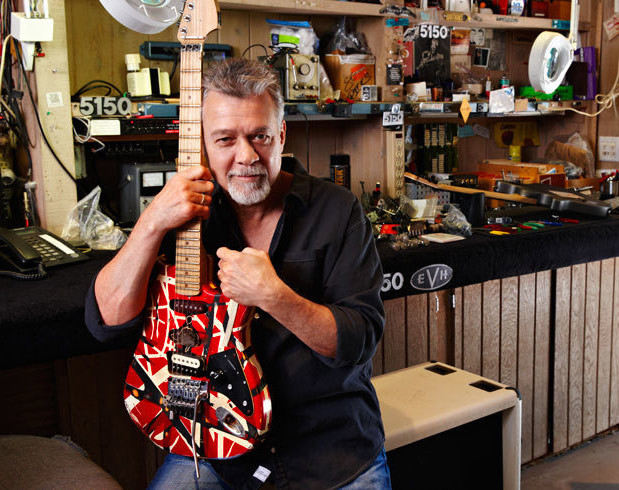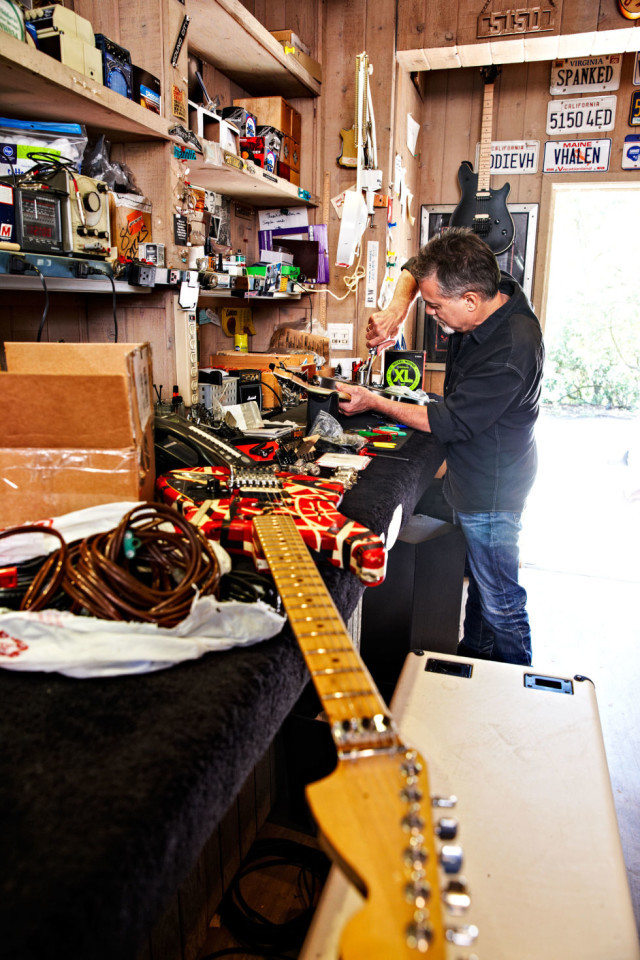Eddie Van Halen wasn’t just a guitar virtuoso; he was a relentless innovator who redefined the sound of rock guitar. Driven by a desire for a unique and powerful tone, Van Halen spent countless hours modifying his guitars and amplifiers, pioneering techniques that are now staples in the guitar world. This article delves into the mind of a true guitar innovator, exploring the key modifications that shaped the iconic “Van Halen Guitar” sound.
Van Halen’s inventive spirit was deeply rooted in his upbringing. As he recounted in a Popular Mechanics interview, his father, a musician himself, instilled in him a “tinkerer” mentality. He shared a story about his father ingeniously adapting a saxophone valve cover to his clarinet after a finger injury, and crafting a Teflon prosthesis to replace missing teeth for playing reed instruments. These early exposures to DIY solutions profoundly influenced young Eddie. “Watching him do that kind of stuff instilled a curiosity in me,” Van Halen explained. “If something doesn’t do what you want it to, there’s always a way to fix it.” This philosophy became the cornerstone of his approach to guitar and amp modification.
 eddie_popular_mechanics_2015_619
eddie_popular_mechanics_2015_619
From Stock Guitar to Signature Sound: Early Modifications
Frustrated by the limitations of commercially available guitars and effects, Van Halen took matters into his own hands. Famously unable to afford a distortion pedal early in his career, he focused on extracting those sought-after overdriven tones directly from his guitar and amplifier. His bedroom became his workshop, the birthplace of many groundbreaking modifications.
One of his first endeavors was tackling the guitar’s pickups. Dissatisfied with the stock sound, Van Halen embarked on replacing them, lacking proper tools but fueled by determination. “I couldn’t afford a router—I didn’t even know what a router was—so I started hammering away with a screwdriver,” he admitted. Despite the crude methods and resulting “chunks of wood” and “sawdust,” he persevered, driven by a clear vision of the sound he wanted to achieve. This DIY spirit and relentless pursuit of sonic perfection are hallmarks of the Van Halen guitar legacy.
Another crucial modification focused on the guitar neck. Van Halen found standard guitar necks too rounded for his playing style. He meticulously reshaped the neck with sandpaper, flattening the profile for enhanced playability. He even went as far as refretting guitars to further flatten the fingerboard. This modification was key to his signature fast playing and wide vibrato. “The flatter it was, the farther I could bend a string without fretting out, or choking the sound when the string hits a fret higher on the neck,” he explained.
Van Halen also addressed the issue of sticky necks on Fender guitars, caused by the thick lacquer finish. He preferred the feel of natural wood, which absorbed sweat and oils, creating a smoother, faster playing surface. When building his own guitars, he opted for unfinished necks, understanding that with time and playing, his own body chemistry would naturally create the ideal smooth surface. This intimate connection between player and instrument, shaping the guitar through sheer use, highlights Van Halen’s unique approach to guitar customization.
 eddie_popular_mechanics_2015_2_FULL
eddie_popular_mechanics_2015_2_FULL
Revolutionizing the Whammy Bar: Staying in Tune
The whammy bar, or vibrato bar, was another area where Van Halen sought significant improvement. Standard tremolo systems of the time were notorious for causing guitars to go out of tune, especially with aggressive use. Van Halen identified the nut, the string guide at the headstock, as a major culprit. The angle of the strings from the nut to the tuning pegs created tension, hindering the strings from returning to their original position after whammy bar use.
To solve this, Van Halen ingeniously crafted his own nut with “really smooth indentations—big and round like the bottom of a boat.” He further enhanced string slippage by adding a drop of 3-In-One oil to the nut slots. Additionally, he modified the string winding technique on the tuning pegs. Instead of winding strings downwards, creating a sharp angle, he wound them upwards, ensuring a level string path from the nut to the bridge. This reduced tension and friction at the nut, dramatically improving tuning stability even with extreme whammy bar techniques.
This innovative approach, however, introduced a minor drawback. The reduced string tension could cause open strings to pop out of the nut slots when played aggressively. Van Halen adapted to this by developing a technique of placing a finger on the far side of the nut to keep the strings in place during open string whammy bar use. This demonstrated his willingness to adapt his playing technique to accommodate his modifications, further blurring the lines between instrument and player.
Amplifier Adventures: Chasing the Hot Sound
Van Halen’s quest for the ultimate tone extended beyond guitars to amplifiers. He was constantly experimenting to push his amps to their limits, seeking that coveted “hot” sound. His explorations were not without peril, as evidenced by his encounter with a capacitor. While experimenting inside an amplifier, he touched a capacitor and received a powerful electric shock, a stark reminder of the dangers of DIY electronics.
His pursuit of overdriven amp tones led him to the discovery of the Variac transformer. Frustrated with Marshall amplifiers that only delivered distortion at ear-splitting volumes, Van Halen sought a way to achieve cranked amp tones at manageable levels. He stumbled upon the Variac while troubleshooting a European model Marshall amp that sounded quiet despite being fully “on.” Realizing the voltage difference was the key, he initially experimented with household light dimmers before discovering the Variac, an industrial-grade variable transformer.
The Variac became an integral part of Van Halen’s rig, effectively acting as a master volume control. By lowering the voltage supplied to the amplifier, he could achieve the saturated, overdriven tones of a fully cranked amp at significantly reduced volumes. This allowed him to achieve feedback and sustain at any volume level, a crucial element of his stage and studio sound. The Variac became synonymous with the “brown sound,” a term often used to describe Van Halen’s warm, saturated, and dynamic guitar tone.
Pickups and the Quest for Tone: A Lasting Legacy
While the original article mentions pickups as one of Van Halen’s early modifications, it ends abruptly before detailing his pickup journey. However, it’s well-known that pickup experimentation remained a constant throughout his career. His initial pickup swaps on his Les Paul Goldtop were just the beginning. He famously combined different pickup types and even potted his own pickups to reduce feedback, always searching for the perfect blend of power, clarity, and responsiveness.
Eddie Van Halen’s relentless experimentation and DIY approach transformed the guitar landscape. His modifications were not just about technical improvements; they were about forging a unique sonic identity. The “Van Halen guitar” is more than just an instrument; it represents a mindset of innovation, a refusal to accept limitations, and an unwavering dedication to the pursuit of personal tone. His legacy continues to inspire guitarists to explore, modify, and ultimately, to find their own voice through the instrument.

 CTGY_EVHGear
CTGY_EVHGear